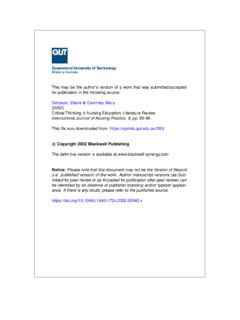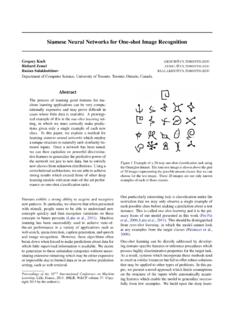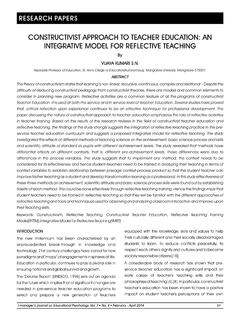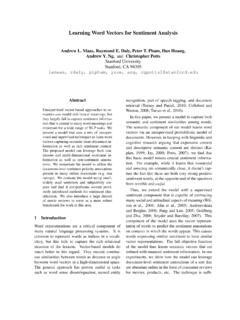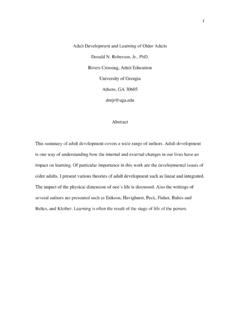Transcription of The effect of learning environment factors on students ...
1 The effect of learning environment factors on students ' motivation and learning Mary Hanrahan, Centre for Mathematics and Science Education, Queensland University of Technology, Australia Copyright 1998 Taylor & Francis Published in: International Journal of Science Education 20 (6) p 737-753 This is the author's version of the work. It is posted here with permission of the publisher for your personal use. Not for redistribution. See publisher s website for the definitive published version.
2 Abstract This paper reports a qualitative study of the learning environment of a Year 11 Biology class. The research was originally framed in a constructivist epistemology, but was also informed by an emancipatory interest. The main methods used for data gathering were participant observation, interviewing, and a written response survey (CES, Tobin, 1993a). It was found that, even though the students viewed the class positively, and described themselves as highly motivated to learn, the level of cognitive engagement was affected by two interrelated factors : the control the teacher had over almost all activities, and student beliefs about learning in this context.
3 The data suggests that both intrinsic and extrinsic motivation which could lead to deep involvement in learning are constrained by a preponderance of teacher-centred methods of instruction. A model is proposed relating intrinsic and extrinsic interest to cognitive engagement. It is concluded that more activities should be used which either implicitly or explicitly reinforce positive beliefs about the need for self-direction in learning . A personal perspective has been included in this paper to indicate the non-linearity of the development of theory.
4 Introduction Most teachers and researchers would like to know more about the factors which may facilitate or prevent students ' deep involvement in learning . This paper is a report of research which explored this question in the context of a Year 11 Biology class. The study grew out of a large research project investigating the relationship between psychosocial learning environment factors and deep learning in science classrooms (McRobbie and Tobin, 1995; Tobin and McRobbie, 1996; Tobin and McRobbie, In press).
5 The project had an underlying interest in whether pedagogical factors usually associated with a constructivist epistemology were more or less likely to lead to worthwhile learning , when compared to a more transmissive method of instruction. My training had largely been in psychology, and my implicit and explicit theories of pedagogy had been deeply affected by recent experience and professional development in adult literacy teaching, and this fact led to my research taking a different turn from that of the other researchers in the team.
6 In particular, I was influenced by humanistic theories of learning ( , Rogers, 1969), as well as androgogy theory (Knowles, 1980, cited in Boud, 1987) and critical pedagogy (Freire, 1972). These theories have in common goals of increasing autonomy for learners and giving a high priority to satisfying learners' needs, but they emphasize different factors . The humanistic school stresses the emotional factors which may inhibit learning and the need for a highly supportive and respectful environment to enable learners to validate and express their personal goals, the androgogy school stresses the importance of a high degree of learner participation in co-structuring progress towards desired ends, and the critical pedagogy school generally stresses the need for student empowerment based on increased collective.
7 Historical and political awareness (Boud, 1987). The combined effect of these theories was to lead me to suspect that emotional aspects of learning , such as feelings of self-worth and autonomy, were likely to be important factors in deep engagement. It can be seen that the above theories and constructivism have similar implications for teaching. Both stress the importance of prior learning , increased learner control and reflection, and the social construction of meaning.
8 Such similarities led me to embrace constructivism readily, and I thought that it was from within such a framework that I was interpreting what I perceived to be going on in the Biology classroom, and what I heard in interviews with the students and the teacher, especially since the interviews were based around a learning environment measure which was intended to tap factors which might influence student construction of meaning (Classroom environment Survey, CES, Tobin, 1993a). My implicit beliefs, however, were also influencing what attracted my attention as telling data.
9 At first I mainly noticed how well-liked the teacher was and the pleasant atmosphere in the class. Then I started to become aware of the way learning was regimented according to pre-set frameworks. At the same time, I had started to notice subtle nonverbal factors which might make some students feel excluded from the group, but I dismissed these as being based on evidence which was too flimsy. Later however, when these started to accumulate, I began to think they might also have an important effect on student engagement at a deep level, even when the level of motivation was high.
10 This resulted in a further study (Hanrahan, 1994), in which I created and tested a new learning environment questionnaire based on my reading of the literature, but also on what I thought at the time were largely intuitive findings from this study. In it I suggested that for constructivist approaches to pedagogy to be successful, they also had to take into account the extent to which the student felt affirmed by the teacher, and the extent to which the student perceived teacher support for autonomy in thinking.







